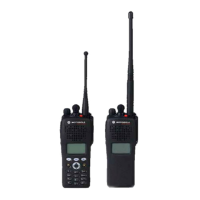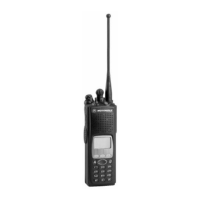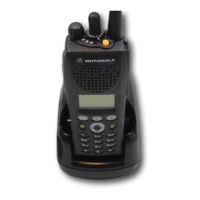Do you have a question about the Motorola ASTRO XTSTM4250 and is the answer not in the manual?
Explains symbols and notations used throughout the manual for clarity and safety.
Provides an overview of the specific radio model being documented.
Details the physical components and layout of the radio device.
Describes controls that can be assigned specific software-activated features.
Explains the radio's screen, its resolution, and what it displays.
Instructions on how to activate and use the display and keypad backlighting.
Explains various symbols displayed on the radio to indicate operating conditions.
Covers menu entries (softkeys), select buttons, and navigation controls for accessing features.
Details the functions of the Home button and the App button, reserved for future use.
Explains the 4-Way Navigation button and the alphanumeric keypad for input.
Explains the meaning of different LED colors and patterns on the radio.
Lists and explains various alert tones used by the radio for different conditions.
Discusses battery types, charging, and charge status indication methods.
Step-by-step instructions for physically connecting and detaching the battery from the radio.
Explains how to view the charge status of a smart battery using the menu or a dedicated button.
Information on installing and removing the radio's antenna.
Instructions for attaching and removing the belt clip from the radio.
Details on how to remove and attach the cover for the universal connector.
Step-by-step guide to powering the radio on and what to expect during startup.
Step-by-step guide to powering the radio off.
Instructions on how to select a desired zone using the menu or a switch.
Instructions on selecting a channel within a zone using the knob or menu.
Explains basic transmit/receive using PTT and volume knob, without special buttons.
Details using a preprogrammed button to set the volume level before transmitting.
Explains how to use the Monitor button to listen for channel activity.
Explains how to select transmit power levels for range and battery conservation.
Covers radio lock features, unlocking, and changing passwords for security.
Explains how to enable or disable the radio lock feature on secure radios.
Instructions on turning keypad tones on or off using the menu or a dedicated button.
Describes analog and digital options for squelch operation to filter received audio.
Explains how to override coded squelch (DPL or PL) for any channel.
Details the time-out timer feature that limits transmission duration.
How to activate an emergency alarm to send a data transmission to a dispatcher.
How to initiate an emergency call for priority dispatch access.
How to send an emergency alarm without audible or visible alerts.
How to view stored lists such as call, page, phone, or scan lists.
Steps to edit numbers within call, page, or phone lists.
Instructions for modifying scan list members and their priorities.
How to enable or disable the radio's scanning feature using the menu or a switch.
How to temporarily remove unwanted channels from a scan list.
Explains how to make dynamic priority changes within conventional scan lists.
How to make a phone call using a preprogrammed one-touch button.
How to answer and start outgoing phone calls on the radio.
Instructions for selecting a number and completing an outgoing phone call.
How to initiate a private call using a preprogrammed one-touch button.
How to receive and start outgoing private calls to other radios.
How to make a selective call using a preprogrammed one-touch button.
Steps to start an outgoing selective call to a specific radio.
How to send a call alert page using a preprogrammed one-touch button.
How to receive and acknowledge an incoming call alert page.
Steps to send an individual or group call alert page.
How to select a talkgroup for group communications in conventional mode.
How to send predefined status messages to a dispatcher.
Instructions on choosing between repeater and direct modes for communication.
Discusses secure radio operation for voice security and digital encryption.
How to select secure or clear transmissions using the Secure/Clear switch.
Information on loading encryption keys and managing them.
How to select and manage encryption keys stored in the radio.
How to select groups of encryption keys (keysets) for different operational needs.
Instructions for erasing single or all encryption keys from the radio.
How to request key reprogramming remotely from a dispatcher.
Explains the feature that displays and transmits the radio's ID number.
How to view the radio's unique identification number.
Explains dynamic regrouping and how to request reprogramming assignments from dispatch.
How radios are classified by dispatchers as Select Enabled or Select Disabled.
Explains the Failsoft feature for continuous communication during system failures.
Describes what happens when the radio goes out of system range.
How to lock the radio to a specific site, preventing roaming.
How to view the current site name and signal strength indication.
How to force the radio to scan and change to a new site.
Instructions for programming the radio's current time and date.
General advice on radio care, cleaning, handling, and things to avoid.
Information on Motorola's maintenance and service programs for the product.
Factors affecting battery life and how to maximize it.
Instructions for charging Motorola batteries using approved chargers.
How the radio indicates battery charge status via LED, sounds, and symbols.
Guidance on recycling and proper disposal of rechargeable batteries.
Information about antenna compatibility and frequency ranges.
Lists approved antenna models compatible with the radio.
Lists approved batteries and related accessories for the radio.
Lists approved accessories for carrying the radio, such as belt clips and cases.
Lists approved chargers and line cords for batteries and connectivity.
Lists various earpieces for discreet audio monitoring.
Lists approved headsets, accessories, and interface modules for audio.
Lists approved external microphones and integrated Commport devices.
Lists approved switches and vehicular adapters for radio use.
Provides definitions for terms starting with A, B, C, and D used in the manual.
Provides definitions for terms starting with E, F, and G used in the manual.
Provides definitions for terms starting with K, L, and N used in the manual.
Provides definitions for terms starting with O and P used in the manual.
Provides definitions for terms starting with R and S used in the manual.
Provides definitions for terms starting with T, U, V, W, Y, and Z used in the manual.
Details the terms and duration of the limited warranty for Motorola communication products.
Outlines general provisions and limitations of the Motorola product warranty.
Explains specific legal rights and instructions for obtaining warranty service.
Lists conditions and damages that are excluded from the product warranty coverage.
Covers Motorola's responsibilities regarding patent infringement claims and software usage rights.
Specifies governing laws and includes concluding notes regarding the warranty.
| Frequency | VHF, UHF, 700/800 MHz |
|---|---|
| Channels | 1000 |
| P25 Compliance | Yes |
| Type | Portable Radio |
| Frequency Range | VHF: 136-174 MHz, UHF: 380-520 MHz, 700/800 MHz: 764-870 MHz |
| Battery Type | Li-Ion |
| Operating Temperature | -30°C to +60°C |











